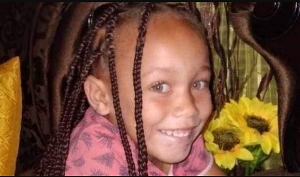 Joshlin Smith has still not been found after going missing from a South African town in February
Joshlin Smith has still not been found after going missing from a South African town in February
Inside a busy primary school classroom in the South African seaside town of Saldanha Bay, one chair is left empty.
This is where six-year-old Joshlin Smith sits - or sat until she went missing in February in a case that has gripped the attention of South Africans.
The huge search operation that involved the navy as well as local volunteers, the big reward, and the arrest of her mother have served to make this an irresistible story.
But the community living with its day-to-day reality remains scared.
Saldanha Bay, about 120km (75 miles) northwest of Cape Town, has the reputation of being a tranquil, quaint town known for its fishing, watersports, and magnificently colourful wildflowers that bloom in spring in the town's nature reserve.
Despite the end of apartheid 30 years ago, the spatial planning in Saldanha, like most cities and towns in South Africa, still reflects the inequalities bequeathed by the system of separate and unequal development.
As one enters the town through the business district, the upmarket housing, which includes guest houses and holiday homes, is located close to the coastline.
But when going into the areas of Diazville and Middelpos, which comprise a mixture of low-cost and informal housing, there is a noticeable change.
The homes in Diazville are mostly government-subsidized basic brick and mortar structures, known as RDP (part of the Reconstruction and Development Programme) homes. In the adjacent Middelpos area there's a mixture of RDP homes and corrugated iron shacks built on an open field.
There is a marked sense of anxiety and suspicion in the two communities, particularly when they see an outsider or a car that is not from the area.
The rise in the number of parents and guardians eagerly waiting to collect their children outside the gates of the modest Diazville primary school is an indication of how much more care is being taken by residents to ensure the safety of young children in the area.
Getting those adults to speak is not easy.
The reluctance is understandable given the media frenzy, and several instances of fake news disseminated on social media, such as alleged sightings and reports of a body being found.
Faeeza Ecksteen, one of the parents who was prepared to talk, was at the school Joshlin attended to fetch her six-year-old son Aleem.
She says the disappearance of Joshlin, also spelled Joslin, has had a serious impact on the community, particularly the children.
"It's a very sad story. All parents are now worried about the wellbeing of their children and are taking extra care to ensure their safety."
"It's traumatising for the children in the area because they no longer want to play outside," adds community activist Carmelite Ross.
"My 11-year-old daughter, Keayondre, didn't want to go to school for the first few days after Joshlin's disappearance because she was scared, even though the school is just a few minutes away. She now walks to school every day with six other children.
"At the end of the day everyone in Saldanha, even our children, has been dragged into this matter."
Despite the end of apartheid 30 years ago, the spatial planning in Saldanha, like most cities and towns in South Africa, still reflects the inequalities bequeathed by the system of separate and unequal development.
As one enters the town through the business district, the upmarket housing, which includes guest houses and holiday homes, is located close to the coastline.
But when going into the areas of Diazville and Middelpos, which comprise a mixture of low-cost and informal housing, there is a noticeable change.
The homes in Diazville are mostly government-subsidized basic brick-and-mortar structures, known as RDP (part of the Reconstruction and Development Programme) homes. In the adjacent Middelpos area, there's a mixture of RDP homes and corrugated iron shacks built on an open field.
There is a marked sense of anxiety and suspicion in the two communities, particularly when they see an outsider or a car that is not from the area.
The rise in the number of parents and guardians eagerly waiting to collect their children outside the gates of the modest Diazville primary school is an indication of how much more care is being taken by residents to ensure the safety of young children in the area.
Getting those adults to speak is not easy.
The reluctance is understandable given the media frenzy, and several instances of fake news disseminated on social media, such as alleged sightings and reports of a body being found.